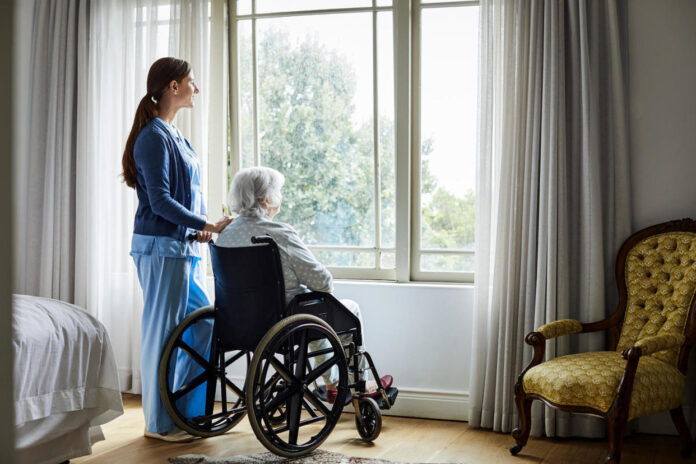The expenditures of caring for sick and elderly loved ones do not appear on store shelves, but they are front and center for voters like Sharon Zimmer.
Zimmer, 65, of Onalaska, Wisconsin, has been caring for her husband, Chuck Zimmer, since his diagnosis of Alzheimer’s and dementia in 2018.
“Everything that we worked so hard for is going back into his care,” said Sharon, one of the more than 38 million unpaid family caregivers to whom Vice President Kamala Harris proposed Medicare coverage for at-home care last week.
According to AARP, the number of U.S. family caregivers has increased by around 4 million since 2015, leading many to leave the employment. Sharon made that decision in 2021, when she gave up the most of her part-time retail career because it became too difficult to balance with caring for Chuck, who is now 67. The move reduced their annual household income by around $24,000.
The couple now has health insurance through Medicare, but they did not qualify for the program when Chuck was originally diagnosed, taking a significant financial hit. Even now, the Zimmers are digging into their retirement funds to pay for his care. Their out-of-pocket expenses are expected to surpass $17,000 this year, excluding security and transportation.
That is far more than the average $7,200 unpaid caregivers bear each year, up from $7,000 in 2016, according to AARP. While overall inflation fell to 2.4% in September, the cost of at-home care for the sick and aged increased by 8.7% compared to the same period last year, according to federal data.
Sharon described Harris’ suggestion as “huge.” While she had been leaning toward supporting Democratic presidential nominee Kamala Harris on women’s rights concerns, she described the new strategy as “a deciding factor for us.”
“As of today, Harris would have my vote,” said Sharon, who lives in a battleground state where Harris will make her sixth campaign stop on Thursday, surrounded by friends who primarily support Republican former President Donald Trump.
Caregiving costs have continued to pressure millions of households, even while price rises in other products and services have slowed or reversed. Many are long-term, necessary expenses that deplete other financial reserves, according to Kelsey Flock, a dementia care specialist at the Aging and Disability Resource Center of La Crosse County in Wisconsin.
“If your loved one is diagnosed younger, they’re losing their retirement, they’re losing their income, maybe losing the primary caregiver’s health insurance,” Flock told me, “so you’re coming up with all of those extras.”
Trump has also promised to reduce caregiver expenses, but he has not detailed any specific legislation. Any proposal to do so by the future administration would very certainly require congressional action.
The Harris campaign stated in a fact sheet that the at-home care program will be completely funded “by expanding Medicare drug price negotiations, increasing the discounts drug manufacturers cover for certain brand-name drugs in Medicare, and addressing Medicare fraud.” The campaign did not estimate the cost of the idea, but comparable ones have been estimated at $40 billion each year.
In response to several requests for comment, the Trump campaign twice issued the identical statement (as written): “President Trump’s economic agenda will make America affordable again for caregivers and elders by defeating historic inflation, lowering prices, and eliminating Social Security taxes.”
The economic expenses of caregiving are not distributed evenly, with women and persons of color bearing disproportionate responsibilities. According to AARP research, the average caregiver spends around 25% of his or her income on out-of-pocket expenses. However, people aged 18 to 34 spend 42% of their income on caregiving. African Americans pay 34%, while Hispanic and Latino caregivers pay 47%.
“My research has shown that Black and Hispanic Medicare beneficiaries are less likely to access higher-quality home health agencies,” said Shekinah Fashaw-Walters, a medical ethics and health policy professor at the University of Pennsylvania’s Perelman School of Medicine. “This lack of access means that it takes more time, more energy, more knowledge and resources for a caregiver to find the support that they need for their loved one.”
Many households, including the Zimmers, discover that Medicare and Medicaid do not cover all of the expenditures associated with elder care, particularly for complicated disorders among patients whose demands alter over time. Medicare pays Chuck’s medication, but not nursing home or in-home care. The pair bought a long-term care policy when they were in their 50s, but they believe the out-of-pocket payments for a memory care center would be prohibitively expensive, and they are not eligible for Medicaid.
These kind of coverage gaps are common, according to David Grabowski, a health care policy expert at Harvard Medical School. “This really highlights just how broken our system is for older adults with dementia and their families,” added the minister.
While the child care affordability crisis has received increased attention, particularly in the 2024 campaign, analysts say senior care issues have remained relatively under the radar. “Even though it is hard work, it is also something that is viewed as rewarding,” said Joseph Gaugler, director of the Center for Healthy Aging and Innovation at the University of Minnesota School of Public Health. “It’s really an issue of public health import.”
And, according to Flock, “if we’re looking at child care, we’re being biased if we’re not looking at elder care.”
A bipartisan bill proposed in January would provide a $5,000 tax credit to caregivers who pay out-of-pocket expenses. AARP supports the bill, which has been presented in Congress five times since 2016, although it has never been debated on the floor.
Before the Harris campaign released its new policy proposal, Sharon Zimmer had her sights set on a proposed $500 caregiver tax credit, which was also supported by AARP and was examined by state lawmakers in recent years but failed to pass. AARP intends to fight for its reinstatement in January.
“Every little bit helps,” she told me, “but deep down, $500 doesn’t even pay for a pair of eyewear.”
